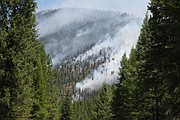Fire crews consolidate effort on Burnt Peak, South Yaak fires
With firefighting resources stretched thin across the country, officials consolidated the Burnt Peak and South Yaak fires under a type two incident management team to share local personnel and equipment more efficiently.
Great Basin Team No. 4, which assumed oversight of the Burnt Peak Fire last Friday, took over management of the South Yaak Fire earlier this week. Jesse Bender, public information officer for the team, said officials were seeing shortages of everything from aviation fuel to bottled water.
Tim Roide, incident commander with the team, said that there were more than 61 large fires in the northern Rockies drawing on resources from 33 incident management teams.
"It’s very important that we share our resources as much as possible and try to get the most usefulness out of them that we possibly can,” said Bender during a July 21 public meeting on the fires in Troy.
The Burnt Peak Fire had spread to 2,136 acres with 15 percent containment as of July 22. Officials had assigned two helicopters, nine engines, two crews, three dozers and 234 personnel to the blaze. The Burnt Peak Fire is burning roughly eight miles southwest of Troy and was started by lightning on July 7.
While brief rain, cool temperatures and higher relative humidity helped firefighters working to contain the blaze, officials said in a statement that they expected warm and dry weather to return on Friday.
The South Yaak Fire had reached 161 acres with 34 percent containment. Eight engines, seven crews, one dozer and 186 personnel were fighting the fire. The blaze was started by lightning on July 13 and is burning north of Troy.
Fire managers are confident that the South Yaak Fire will not continue spreading on its eastern edge thanks to firelines and firefighters cooling that section of the blaze with hoses. Firefighters are still working to contain the western edge.
Officials have not issued evacuation notices for either fire, but have put some residents living near the Burnt Peak Fire on pre-evacuation notice.
Both fires will likely require long-term management that will outlast Great Basin Team No. 4’s involvement in the area; Bender said the type two incident management team is on a two-week assignment in Lincoln County.
Despite the bottleneck for resources, Kootenai National Forest officials have succeeded in bringing more material and firefighters, including four hotshot crews, due to their emphasis on initial attack, according to Monica Morrison, planning operations trainee with Great Basin Team No. 4.
“One of the things that we’ve heard since we got here is how much success the local unit has had with initial attack,” said Bender.
Protecting lives, structures and timber values remain the top priorities for Great Basin Team No. 4, according to Roide. Though officials have not ordered evacuation notices, he urged residents to be prepared to leave their homes if need be.
Property owners near the fires should visit the Ready, Set, Go website for information on being ready for wildfires.




